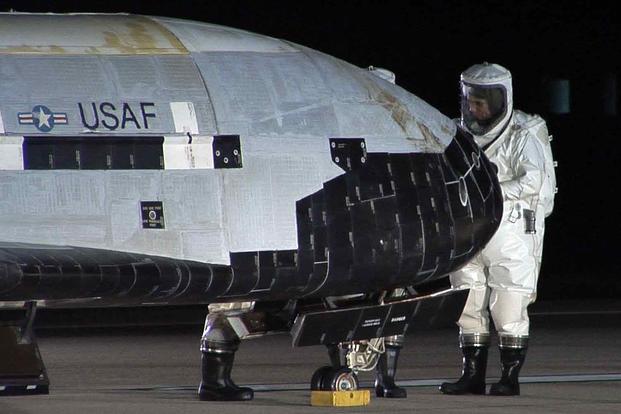The U.S. Space Force has created a unit dedicated solely to orbital warfare -- and it includes the secret experimental X-37B space plane.
Space Force members overseeing the unmanned spacecraft are part of the newly established mission delta unit known as Delta 9, according to the service. The Drive was first to point out that the X-37B, previously under the purview of the Air Force, has found a new home.
Read Next: Military Sending Rape Cases to Court-Martial Without Enough Evidence to Convict, Report Finds
Delta 9's Detachment 1 "oversees operations of the X-37B Orbital Test Vehicle, an experimental program designed to demonstrate technologies for a reliable, reusable, unmanned space test platform for the U.S. Space Force," according to the unit's fact sheet.
The Space Force is in the process of standing up its three primary field commands and its subordinate units transferring from the Air Force: Space Operations Command, Space Systems Command and Space Training and Readiness Command, which will be responsible for training space professionals; acquiring space systems from industry; and supporting combatant commanders with space force personnel and capabilities.
Space Operations Command was activated last month during a ceremony at Peterson Air Force Base, Colorado.
Under the field commands are deltas and squadrons, according to the Space Force's command hierarchy.
Nine Space Deltas fall under Space Operations Command, according to a chart published last week. Delta 9 consists of three active-duty squadrons headquartered at Schriever Air Force Base, Colorado: 1st Space Operations Squadron, 3rd Space Operations Squadron and 750th Operations Support Squadron, along with Detachment 1. The three squadrons conduct "protect-and-defend operations from space and provide response options to deter and defeat adversary threats in space," according to the chart.
Since 2010, the X-37B has been used to explore the practicalities and risks of "reusable space vehicle technologies," according to the Air Force. The low-earth orbit vehicle, which often carries classified payloads, completed its fifth unmanned space mission last year, spending 780 days in space and breaking the previous record of 718 days. The test vehicle can autonomously re-enter the atmosphere and land on a flight line.
In May, the X-37B launched for its sixth mission from Cape Canaveral Air Force Station, Florida, to conduct operations for the Space Force, NASA and other agencies, Air Force Secretary Barbara Barrett said at the time.
"This important mission will host more experiments than any prior X-37B flight, including two NASA experiments," she told viewers during a conference hosted by the Space Foundation.
One NASA experiment will "study the results of radiation and other space effects on [specific] materials," while the other will research "ambient space radiation" effects on seeds used to grow food, Barrett said.
The X-37B also carried the FalconSat-8, a small satellite developed by the U.S. Air Force Academy and sponsored by the Air Force Research Laboratory, with "five experimental payloads," officials said. The U.S. Naval Research Laboratory also sent up testing materials used to turn solar power into radio frequency microwave energy, which could then be transmitted to the ground.
-- Oriana Pawlyk can be reached at oriana.pawlyk@military.com. Follow her on Twitter at @Oriana0214.
Related: Former SecAF Explains How Secret X-37 Space Plane Throws Off Enemies












